Spectrophotometric Determination of Chromium(III) and Iron(III) by used of 2-((E)-(1H-Benzo[D]Imidazol2-Yl)Diazenyl)-5-((E)-Benzylideneimino) Phenol;(BIADPI) as Organic Reagent
Khalid J. Al-Adilee, Shaimaa M. Eassa and Haitham K. Dakhil
Department of Chemistry, College of Education, University of Al – Qadisiya, Iraq.
Corresponding Author E-mail: khalid.jawad@qu.edu.iq
DOI : http://dx.doi.org/10.13005/ojc/320518
The azo reagent 2-((E)-(1H-benzo[d]imidazol2-yl)diazenyl)-5-((E)-benzyl ideneimino)phenol(BIADPI) was prepared and examined by using element analysis(C.H.N.),UV-Vis., Mass spectrum, 1H-NMR spectrum and infrared spectra. A sensitive and selective spectrophotometric method is proposed for the rapid determination of iron (III) and chromium(III) using (BIADPI) , as spectrophotometer reagent. The reaction between this reagent with chromium(III) and iron (III) is instantaneous at (586,536) nm (λmax) and pH=(7.5,4) to form perpul complexes having a mole ratio 1 : 2 (metal : ligand) for Cr (III) and Fe(III) the absorbance remains stable for over 24 hours. Beer's law is obeyed in the rang of (1-14) μg.ml-1 and (1-21) μg.ml-1with molar absorptivity (Є) = (7.768x105 , 9.3575x105) L.mol-1.cm-1 and a detection limit of (0.275-0.14) μg.ml-1 obtained respectively. The precision and accuracy were obtained to be R.S.D%=(0.9-0.467)%,Re%=(99.1-98.2-)% and Erel%= (-1.8 - 0.9)%.The method is successfully employed for the determination of iron(III) in Pharmaceutical preparations(Anemiadrugs).The most important interferences were due to Ni(II), Zn(II), Co(II), Cd(II), Cu(II)and Hg(II) and suitable masking agents were used.
KEYWORDS:(BIADPI); Determination; Chromium; Iron; Spectrophotometry; Schiff base
Download this article as:| Copy the following to cite this article: Al-Adilee K. J, Eassa S. M, Dakhil H. K. Spectrophotometric Determination of Chromium(III) and Iron(III) by used of 2-((E)-(1H-Benzo[D]Imidazol2-Yl)Diazenyl)-5-((E)-Benzylideneimino) Phenol;(BIADPI) as Organic Reagent. Orient J Chem 2016;32(5). |
| Copy the following to cite this URL: Al-Adilee K. J, Eassa S. M, Dakhil H. K. Spectrophotometric Determination of Chromium(III) and Iron(III) by used of 2-((E)-(1H-Benzo[D]Imidazol2-Yl)Diazenyl)-5-((E)-Benzylideneimino) Phenol;(BIADPI) as Organic Reagent. Orient J Chem 2016;32(5). Available from: http://www.orientjchem.org/?p=21220 |
Introduction Azo Schiff base compounds are very important well known and generally used substances in cosmetics industries and textile paper and coloring agents for foods [1].Azo Schiff bases essential intermediates for the production of some applications for example biological activity[2-4],analytical[5,6],Anticancer[7,8],clinical[9,10], and catalystical[11].Azoschiff bases compounds derivative from the reaction between the Schiff derived from the reaction of aromatic aldehydes and aliphatic or aromatic amines represented important series of widely studied organic reagent [12] . Azoschiff base and their complexes with transition metal ions are also of importance due to their complexing, catalystical, biological properties[13].and corrosion inhabitation in acid media[14,15].This class of azo compounds posses active (π- acidic) azo imine (-N= N-C=N-) function, for this reason a number of these azoimidazoles were prepared and their abilities as chelating ligands was investigated[16-18]. Chromium exist in natural water in two stable oxidation states, Cr(III) and Cr(III). Among these two predominant forms, Cr(III) is considered to be essential to mammals for the maintenance of glucose, lipid and protein metabolism, where as Cr(III) is a toxic and S460 SUVARAPU et al. carcinogenic form[17-19]. Because of the above reasons the determination of chromium in environmental and biological samples is of great interest. Determination of Cr(III) in micro quantities is of interest to analytical chemists. Although AAS is the most common method of chromium detection. Besides AAS,a number of other methods has been reported for Cr(III) determination such as NAA, ICP-MS, ICP-AES[21-23]. Moreover, such techniques are usually not available in most laboratories. Because of expensive cost of the above instruments most of the researchers are still interested in colorimetric andspectrophotometric methods[24].Iron is an essential nutrient. World Health Organization(WHO) estimation for iron minimal daily requirements depends on age, sex and man physiological status, and they range from 10 to 50 mg/d. The average lethal dose for iron is 200-250 mg/kg body weight. However, literature presents data for death cases resulting from swelling of 40 mg/kg body weight doses[25]. In this paper we report, 2-((E)-(1H-benzo[d]imidazol2-yl)diazenyl)-5-((E)-benzyl ideneimino)phenol(BIADPI) , which was prepared by Al – adilee[26] ,as an analytical reagent for the micro determination of Fe(III) and Cr(III). The method has been found to be simple, rapid and sensitive for the determination of these metal ions. Experimental Materials and Methods All chemical which are of analar grade are purchased from Aldrich ,BDH,Merck,GCC,England and Sigma.All the solvents used Ethanol,methanol,dimethylsulfoxide and Teterahydrofuranare of Analargrade.The solvents were purified by distillation and double distilled water was used throughout the experiment.The infrared spectra of the ligand(BIADPI) and their metal complexes were run as KBr discs in in range(4000-400)cm-1on a shimadzu 8400 FTIR spectrophotometer. Element analysis (C.H.N) were performed by using a Euro EA elemental analyzes.1HNMR spectrum of ligand were determined in CDCl3(internal standared TMS) on Bruker spectrophotometer (Tarbiatmodarresunivesity,Iran),Mass spectrum of ligand was obtained using Agilent Technologies 5975C at 70e and MSD energy using a direct insertion probe (Acqmethod low energy) at temperature 90-110oC(TarbiatModarresuniverstry,Iran). absorption spectra were measured on aT80 UV-Vis spectrophotometer and absorbance were measured on Apel PD -303UV-visible spectrophotometer using 1 cm quartz cells,The metal contents of the complexes were measured by using atomicabsorption by aPg AA-6300 Atomic absorption spectrophotometer , A model WTW multi 720, pH – meter was used to adjust and measure the pH of the solution , melting point was measured using SMP30 Stuart, UK. Experiments and preperation of solutions and washing all glasses , distilled water is used twice doubly distilled water. Prepartion of Novel Azo-schiff Base Ligand (BIADPI) The novel azo-schiff base ligand (BIADPI) was prepared by condensation of benzaldehyde (3.41 g; 0.01 mole) with 3-amino phenol (1.09 gm; 0.01 mole) in 30 ml ethanol in the presences 5 drops of glacial acitic acid as a catalyst and the mixture was refluxed for 5 h. at 60oC.The resltant solution was cooled at room temperature .The dark yellow solid of 3-(benzylidene amino )phenol was formed was filtered and recrystallized in absolute ethanol.Yield 87% ;m.p=149oC .Azo compound was prepared by the diazotization coupling reaction using procedure described for arylazo -imidazole dyes[26].with some modification Scheme(1).2-Amino benzimidazole(1.33 gm, 0.01 mole) was dissolved in mixture 25 ml distilled water and 5 ml of concentrated hydrochloric acid and cooled to 0-5oC.The solution was diazotized at 0-5oC with (0.75 gm;0.01 mole) sodium nitrate was disolved in 25 ml distilled water was added drop wise to solution of 2-amino benzimidazole and stirring continuously at 0-5oC and left to stand 30 min .This diazonium solution was added to (1.97 gm ;0.01 mole) of 3-(benzylidene amino)phenol was dissolved in 100 ml ethanole and 30 ml of 6% sodiume hydroxide.The mixture was stirred continuously for 2 h. at 0-5oC in ice-bath and allowed to stand over- night.The precipitate was filtered and washed with distilled water and ethanol solution to remove the excess ofunreacted substances and recrystallized from ethanol and dried in oven at 50oC for several hours.The purity was confirmed by the elemntal analysis and TLC techniques.Yield;79%:m.p; 160oC. Reagent and Solutions All the chemicals used were of analytical reagent grade, and were used without further purification. Ethanol were purchased. -1×10-3M (BIADPI) standard solution was prepared by dissolving (0.0342)g in 100 ml of absolute ethanol . -Stock Cr(III) solution;A solution of Cr(III) (1000 µg.ml-1) was prepared by dissolving (0.5210 g) of CrCl2.6H2O in 100 mL deionized water. Other standard solutions of Cr(III) were prepared by dilution of stock solution with distilled water . -Stock Fe(III) solution ;A solution of Fe(III) (1000 µg.ml-1)was prepared by dissolving (0.3025)g of FeCl3 in (1 ml) in (HCl) and full the flask to (100ml) by deionized water. Other standard solutions of Fe(III) were prepared by dilution of stock solution with distilled water . The pH of the medium (2-9) was adjusted with ammonium acetate (0.01 mol L–1) –ammonia – glacial acetic acid buffer solution . General Procedure Into a 10 mL calibrated flask , transfer 1 mL of sample solution containing less than 100 µg.ml-1 of Cr(III) and adjust the pH to 7.5 with ammonium acetate buffer, add 1 ml 1.0×10-3M ethanolic (BIADPI) solution and diluted to the mark with deionized water. The absorbance of the resultant solution was measured after 10 min. at 586 nm at 25 C against the corresponding reagent blank prepared under identical conditions but without Chromium ion. transfer 1.5 mL of sample solution containing less than100 µg.ml-1 of Fe(III) and adjust the pH to 4 with ammonium acetate buffer, add 1 ml 1.0×10-3M ethanolic (BIADPI) solution and diluted to the mark with deionized water. The absorbance of the resultant solution was measured after 10 min. at 536 nm at 25 C against the corresponding reagent blank prepared under identical conditions but without Iron ion. Results and Discussion Mass Spectrum of the Novel Azo-Schiff Bases Ligand (BIADPI) The mass spectral fragmentations of azo-schiff bases ligand (BIADPI) shown in scheme-1 and figure 1.The base peak of azo-schiff base ligand at m/e+=342.30 is attributed to the original molecular weight of the ligand (341.37) under investigation.The peak at m/e+=239 is analougs to the loss of phenyl and azomethine (NCH) group.The loss of two nitrogen atoms (azo group) give a peak at m/e+=211.The peak at m/e+=159 due to loss of C4H4.The same spectrum show a peak at m/e+=139 corresponding to loss of hydroxyl group and three hydrogen atoms from imidazole ring[27,28]
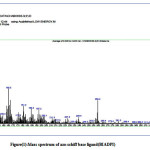 |
Figure 1: Mass spectrum of azo-schiff base ligand(BIADPI) |
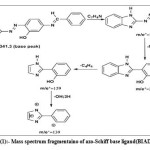 |
Scheme 1: Mass spectrum fragmentaino of azo-Schiff base ligand(BIADPI) |
1H-NMR Spectrum of Azo-Schiff Bases Ligand (BIADPI). The 1H-NMR spectrum of the azoschiff base ligand figure (2) was measured using in CDCl3 as a solvent.The azoschiff base spectral results show a dblate peaks at δ=6.51-6.54 ppm attributed to phenol ring.Thetriblate peaks at δ =7.27-7.28 ppm attributed to the phenyl ring .The single peaks at δ =6.77 ppm and 6.78 ppm due to the NH and OH groups in ligand respectively.Also the same spectrum display signal at δ=7.58 ppm which are assigned to the phenyl ring of benzimidazole.Theazoschiff base ligand shows single peak at δ=8.57 ppm which is assigned to the presence of protons of azomethine group[29,30].The singal peak at 1.26 ppm is due to the existence of CDCl3 solvent.
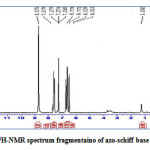 |
Figure 2: 1H-NMR spectrum fragmentaino of azo-schiff base ligand (BIADPI) |
Infrared Spectra The infrared spectroscopic data of reagent and their complex with Fe(ш), and Cr(III) spectra are complicated owing to the extensive overlap of number of bands arising due to υ(O─H), υ(C═N),υ(N═N) and other bands originate due to phenyl and benzimidazol rings appeared in the region below 1650 cm-1, the comparison between spectra of the reagent with those of two coordination complexes have revealed certain characteristics :- The IR spectrum of reagent (BIADPI) gives characteristic broad band at 3601 cm-1 assigned to the phenolic υ(O─H). This suggests a strong intermolecular hydrogen bonding [31]. The spectra of Cr(III) and Fe(III) complexes show broad and weak bands around (3194-3480)cm-1 which indicate the presence of water molecule in these complexes[32]. The free reagent shows medium band around 3323 cm-1which can be attributed to υ(N-H) stretching vibration of benzimidazol moiety[26]. The band appears at (3257-3318 ) cm-1 in solid chelate complexes of Cr(III) and Fe(III) spectra.Thus the remaining of the hydrogen of (N-H) group indicates non involvement in coordination of the reagent to the metal ions[26]. The spectrum of reagent shows absorption band at 1620 cm-1which is considered to be υ(C═N) of benzimidazol ring[31].This band shifts to lower frequency (1511-1497) cm-1with a little change in shape in the metal complexesc spectra. These differences suggest the linkage of metal ion with nitrogen of hetrocyclicring[32]. The azo group intens bands at 1481 cm-1 are due to asymmetric and symmetri stretching vibrations of the ─Ν═Ν─ group ,respectively[33].The band appears at (1452-1434) cm-1respectively with some decrease in intensity of metal complexes spectra.Both bands shifted and reduced in intensity this may indicate that azo group is coordinated to the metal ions to the formation complexes[34]. The appearance of weak intensity bands in spectra of metal complexes in the region of (560-460) cm-1assignable due to υ(M-O) and υ(M-N) vibration,also indicated the metal oxygen binding to formation of the chelat complexes [35].IR spectra data lead to suggest that the novel azoschiff base behaves as tridentate chelating agent coordination through the nitrogen atom (N3) of azo group nearest to phenol ring,phenolic oxygen and nitrogen (N3) atom of benzimidazole ring to give two-five membered chelate ring.Representaive examples for these spectra are given in figures 3,4 and 5 .
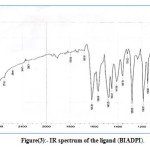 |
Figure 3: IR spectrum of the ligand (BIADPI). |
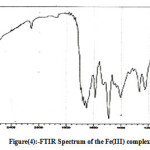 |
Figure 4: FTIR Spectrum of the Fe(III) complex |
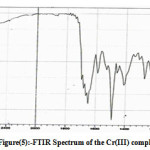 |
Figure 5: FTIR Spectrum of the Cr(III) complex |
Absorption spectra The UV- Vis spectrum of an ethanolic solution of the reagent (BIADPI) (1×10-3 M) showed peak (λ max) was observed at the (249-326 nm) due to the (π-π*) from aromatic ring through the azo group (charge transfer) and (450 nm) was referred to the n- π* transition of intermolecular charge- transfer taken place from benzene through the azo group(-N=N) these spectra are given in figure 6.
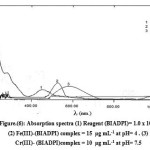 |
Figure 6: Absorption spectra (1) Reagent (BIADPI)= 1.0 x 10-3 M (2) Fe(III)-(BIADPI) complex = 15 μg mL-1 at pH= 4 . (3) Cr(III)- (BIADPI)complex = 10 μg mL-1 at pH= 7.5 |
Characteristics of the Complexes Interaction of the metal ions Cr(III) and Fe(III) with the reagent has been studied in aqueous ethanolic solution . A bathchromic shift of Cr(III) and Fe(III) complexes show the absorption maxima of 586 and 536 nmwith molar absorptivities (ε) of( 7.768×105 and 9.3575×105) L.mol-1.cm-1 obtained respectively while the reagent gave the absorption maxima of 450 nm. The wave length difference ( Δλmax) is (136-86 nm) ,a great bathochromic shift in the visible region has been detected in the complex solutions spectra with respect to that of the free reagent. The high shift in the (λmax) gave a good indication for complex formation. Method Validation Under the optimized conditions, the calibration graphs were constructed by plotting the absorbance signal against the concentrations of each analyte subjected according to the general procedure. The solutions were transferred into the optical cell of 10-mm for the measurement of each metal ion spectrophotometricallyat the respective absorption maxima against a reagent blank prepared under similar conditions .The calibration data and some analytical parameters are summarized in Table(1). Table 1: Analytical data and some analytical parameters of the proposed method for determination of Chromium(III) and Iron(III)
| Analytical Parameter | Fe (III) / ppm | Cr (III) / ppm |
| λmax(nm) | 536 | 586 |
| Regression equation | Y=0.0207X+0.0106 | Y=0.0198X+0.0076 |
| Molar absorptivity(L.mol-1.cm-1) | 9.3575×105 | 7.768×105 |
| Sandell sensitivity(µg.cm-2) | 0.0483 | 0.0505 |
| Correlation coefficient(r) | 0.9994 | 0.9995 |
| Detection limit(D.L) | 0.14 | 0.275 |
| Lineardynamic range | 1-21 | 1-14 |
| Standerd deviation | 0.0015 | 0.00187 |
| Relative Standard deviation % | 0.467 (N=7) | 0. 9 (N=7) |
| Percent relative error | 0.9 | -1.8 |
| Percent recovery | 99.1 | 98.2 |
| Composition of complex [M: L] | 1:2 | 1:2 |
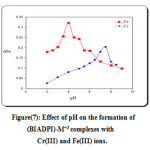 |
Figure 7: Effect of pH on the formation of(BIADPI)-M+3 complexes with Cr(III) and Fe(III) ions. Click here to View figure |
As can be seen in Figure.(3), the absorbance first increased with increasing pH and reached a maximum at pH 4 for Fe(III) and 7.5 for Cr(III) complexes ,respectively. The absorbance graduallydecreased may be due to formming another chromophoricformala of reagent at higher pH . Therefore, pH 4 and 7.5 were selected as the optimum pH for complete formation of Cr(III) and Fe(III)complexes,respectively. Effect of Temperature and Time The effects of temperature and time were examined due to their importance for the reaction completion . Consequently, a study was carried out to choose the range of temperature that enhances higher absorbance signals for Cr(III) and Fe(III) ions. The temperature was varied from 10 ᴼC to 80 ᴼC in a search of optimum value. It can be seen from Figures. 8 that the highest absorbance signals were achieved when the temperature at approximatly (20-40) ᴼC.It was also observed that the incubation time of 5 min for Fe(III) and 10 min are sufficient for the maximum absorbance of Cr(III) Figures. 9.
 |
Figure 8: Effect of the temperature on the absorbance for (BIADPI)-M+3 complexes with Cr(III) and Fe(III) ions. Click here to View figure |
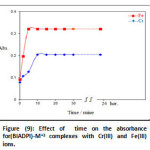 |
Figure 9: Effect of time on the absorbance for(BIADPI)-M+3 complexes with Cr(III) and Fe(III) ions. Click here to View figure |
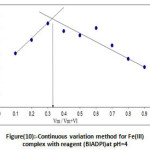 |
Figure 10: Continuous variation method for Fe(III)complex with reagent (BIADPI)at pH=4 |
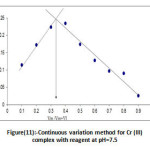 |
Figure 11: Continuous variation method for Cr (III) complewith reagent at pH=7.5 |
According to their results and discussed through different techniques the proposed structural formula of chelate complexes prepared is suggested and shown in figure 12.
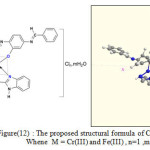 |
Figure 12: The proposed structural formula of Cr(III) complex Whene M = Cr(III) and Fe(III) , n=1 ,m=1 |
Analytical application The proposed spectra photometric method will be of invaluable for the determination of iron (III) in Pharmaceutical preparations(Anemiadrugs). The result obtained from the proposed method was compared with those given by atomic absorption spectroscopy(AAS),(standard additions method). The concentration of iron (III) analyzed by the proposed method show a good agreement of the results obtained by the two methods. Table 2: The percentage of iron in a manner and atomic absorption method under consideration
| Already existsin the form ofthe model(Ferbas syrups ample) | Calculatedunderway% Fe | flameatomic absorption method |
| 30 mg | 29.34 | 29.02 |
Interference Studies Chromium(III) and Iron(III) Complexes The effect of the interference of ions which form complexes with the reagent (BIADPI) during its reaction with {( Chromium(III) 10 ppm and Iron 15 ppm} were studied. The selectivity of various masking agents are examined for eliminating the effect of the interfering eight ions for each one . These are 5-Sulfosalicylic acid ,NaNO2,Sodium acetate, Oxalic acid, Tartaric acid,Na2S2O3,KCl and KI. The results are shown in tables(3,4). Table 3: Effect of foreign ions on the determination of Cr(III) in concentration (10)ppm and suitable masking agents.
|
Error% |
Masking agent(1.0)ml ٫[0.01]M |
Foreign ion 100 ppm |
|
0.003 |
5-Sulfosalicylic(0.5)[0.01] |
Cu2+ |
|
-0.001 |
NaNO2(0.2)[0.1] |
Ni2+ |
|
0.002 |
Sodium acetate (0.5) [0.01] |
Zn2+ |
|
-0.004 |
Sodium acetate (1.0)[0.01] |
Hg2+ |
|
0.004 |
5-Sulfosalicylic(0.75)[0.01] |
Cd 2+ |
|
-0.002 |
Oxalic acid (0.4) [0.2] |
Co2+ |
Table 4: Effect of foreign ions on the determination of Fe(III) in concentration (15)ppm and suitable masking agents .
|
Error% |
Masking agent(1.0)ml ٫[0.01]M |
Foreign ion 100 ppm |
|
0.002 |
Na2S2O3 (1.0)[0.02] |
Cu2+ |
|
0.004 |
Tartaric aid (2.0)[0.01] |
Ni2+ |
|
0.001 |
Na2S2O3(0.2)[0.1] |
Hg2+ |
|
0.03 |
KCl (0.2) [0.01] |
Zn2+ |
|
0.03 |
Na2S2O3 (1.0)[0.01] |
Cd2+ |
|
0.03 |
KI(0.4)[0.1] |
Co 2+ |
Conclusion In this work 2-((E)-(1H-benzo[d]imidazol2-yl)diazenyl)-5-((E)-benzyl ideneimino)phenol(BIADPI)was used for determination of microamounts of Cr(III) and Fe(III).The molar absorpinity of this complaxes are 9357.53 , 7768.7 l.mol.cm-1respectirelly.Most foreign ions donot interfere with ions study when masked using different masking agents . Because the (BIADPI) can rapidly react with Cr(III) and Fe(III) at room temperature , this method can determine these ions spectrophotometrically without heating or extraction . It is sensitive , selective , rapid , easy and convenient method for determining the ions Cr(III) and Fe(III) . Refrence
- Eissa H. H.J.CurrentRes.Sci .2013,12, 96-103.
- Jian,L.V.JInorg.Biochem.2006,100,888.
- Balasurbramanian,K.p.spectrochimicaActapart A:MolBiomol.spect. 2007,6850.
- Tumer,M.;Ekinci,D.;Tumer,F.A.spectrochimicaActapartA:MolBiomol.spect. 2007,67,916.
- Fakhari, A.R.;Khorrami, A.R. ;Naeimi, H.Talanta.2005, 66, 161-162.
CrossRef - Gholivand, M.B.Talanta .2007, 73,553.
CrossRef - Pathak, p.;Jolly, V.S;Sharma,K.p.orient J.Chem.2000, 16,161-162.
- Desai, S.B;Desai, P.B.; Desai, K.R.Metrocycl. Commun.2000,7,83-90.
- Huong, Z.ThermochimicactaA.1998, 320-121.
- Taguchi, T.J.Am.Soc. Nephrol.2002 ,13,2478.
CrossRef - Virginie, C.Teterahedronlett.2007, 48,5561.
CrossRef - Asieh, Y. ;vahidAzimi.Eur-chem. Bull.2013, 2(7), 453-455.
- salih, A. A.;shaker ,sh.A. oriental J.Chem. 2011, 27(3), 835-845.
- EL-ajaily,M. M.; Abdulla ,F.I.;suliman,M.s.;Akasha,R.A. Asian J. of Adv.Basic sci. 2014, 2(2), 17-30.
- EL-ajaily,M. M.; Abdulla ,F.I.;Akasha,R.A.;suliman, M.s.J.Chem. pharm. Res.2013, 5(12), 1144-1161.
- AL-adilee, K.J. ;HessoonH.M. Journal of Chemical and Pharmaceutical Research.2015, 7(8),89-103.
- Turyan, I.;Mandler, D.Anal Chem. 1997, 69,894.
CrossRef - Krishna, M.V. B. ;Chandrasekaran, K.Talanta.2005,65, 135–143.
- Nriagu J O and Nieboer E, Chromium in the Natural and Human Environment. John Wiley and Sons, New York, 1989.
- Ressalan,S.;Chauhan, R. S.;Goswami, A. K .;Purohit, D. N.Rev Anal Chem. 1997,16(2),69.
CrossRef - Takeda ,K.; Watanabe, S.;Naka, H;Okuzaki, J.; Fujimoto, T.Anal Chim Acta.1998, 377,1, 47 .
- Satyaveni S, Preconcentration and Determination of Trace Metals by ICP-AES, Ph.DThesis, S.V.University, India, 2007.
CrossRef - Ahmed, M. J.;Jahan, I. ;Banoo, S.Anal Sci. 2002, 18,805.
CrossRef - Georgieva, N.;Dospatliev,L.;Yaneva, Z. Trakia Journal of Sciences.2010, 8(2) ,511-516.
- AL-Adilee, K. J.RJPBCS.2015,6(5),1297-1308.
- Elajaily,M.;Ramadan, A.J.Chem.Pharm.Res. 2013,5(12),1141-1151.
- AL-Adilee, K. J.;Fanfon, D.Y. J.Chem.Chem.Eng. 2012,6,1016-1028.
- Habeeb,H. A.;AL-Adilee, K. J.;Jaber,S. A. J.Chem.and Mater.Res.2014,6(8),69-80.
- KumerN.;Mishra,P. Sh.Arch .Appl.Sci.Res. 2001,5(5),191-197.
- Mehdi ,R.T. ;Ali ,A.M.IBN AL-Haitham, J. of pure and appl.Sci.2005,18(2), 50-58.
- Ali, A.M. Nat.J. of Chem.2006,23.,335-343.
- Masoud, M. S. ;Mhamed, G. B.;Abdul-Razek,Y. H. J. Korean.Chem. Soc.2002, 46(2), 99-116.
- Ali,A.M.;Kadhum M.O. ;AlHamdany Z. .M.B.J.Al-Qadisiya for pure science.2006, 3,(11),134-146.
- [34]AL-Adilee, K. J.;Abass, A. K. ;Taher,A. M. Journal of Molecula Structure.2016,1108,378-39.
CrossRef

This work is licensed under a Creative Commons Attribution 4.0 International License.









